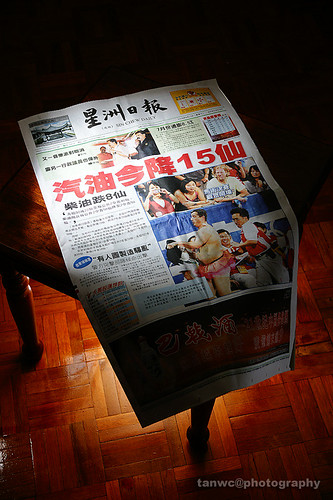Exif: f/16, 1.0 sec, ISO 100, 16mm
It's a photo I shot with a flash from camera left. It is possible to add flash with long exposure photography. The fraction of the second of a flash does not effect the end result of the photo. The burst from the flash will be capture first, and long exposure will allow the ambient to take place. With the camera mounted on a tripod, cover the pop up flash with an exposed film and hold the flash at any location I wish to light.
This photo show how it look if without a flash is being used:
Exif: f/16, 1.0 sec, ISO 100, 16mm
Pretty well lit and everything seem to be fine. However, I still do find this pic is lack of something. I wish to make the rock at the foreground look more stand out from the surrounding area. Some test shoots with off camera flash were done, but somehow the ambient is too bright and it kills the effect of the flash. I even tried 1/3th of a second to see if the ambient is bright enough to bring out the scene, but this is what I got:
Exif: f/16, 1/3s, ISO 100, 16mm
It's too dark. Well, I was pretty satisfy with the second photo of this post, and I was ready to go. But before I could ever pull up my tripod, the ambient light dropped in a sudden. I quickly did a shot with 1.0 sec exposure plus an off camera flash. My F42 flash setting was at 1/4 level (if I remember), zoom at 105mm, and I got this :
Exif: f/16, 1.0 sec, ISO 100, 16mm
I like this shot, but somehow I do not like the flash spill on foreground and the rock doesn't look good. I figured out that my angle of attack from my flash, and the extra spill on to the ground had caused the unwanted flash spill behind the rock group. I didn't bring my snoot with me, but I have a lens cover. Hence, with the ambient still low, I quickly set my camera to 10s timer, changed my angle of attack of my flash, with the lens cover covering the lower part of my flash head, and pop and I got the first photo shown in this post.
Why cover lower part the the flash head? The cover has acted like a gobo that prevent the flash from spilling to the down side of the flash. Hence, it prevents the flash light from spilling to the water below the rock.
Combining off camera flash with long exposure is simple and easy to be done. We can make use of our build-in wireless flash function to do this kind of photography. What we need to know is to understand how the light "see" the subject, and how the subject to be "seen" by the camera. Besides, photography is all about light, correct ?
Learn all about strobist here at www.strobist.com.

















